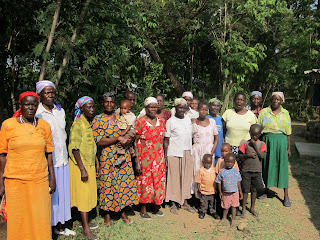 |
| Takawiri Beach |
Mfangano Island is west of Rusinga, and it's a larger and considerably more lush piece of land. As we approached in the small fishing boat we rode on for the day, Dan Nyangweso gave us a short geography lesson. The people of Mfangano, by ancestry the Suba tribe from Uganda who, over the years, has mixed with the Kenyan Luo tribe, have done a remarkable job at preservation. Subsistence farming and fishing were about it as far as industry, similar to Rusinga, but the number of trees covering the hillside set the island apart. That allows Mfangano to be a more attractive destination for tourists, though, outside of an airstrip and one small resort with float planes, as well as boat trips over from Rusinga, it seems like access is still limited.
The fishing villages suffer the same sketchy reputation as those on Rusinga (namely, fisherman are transient and tend to bring problems like alcoholism and prostitution, as well as living conditions of corrugated tin dwellings and environmental problems that result come from washing and bathing in the lake). However, slightly different weather patterns help prevent drought on the island, and sustainable farming practices have prevented erosion or clear-cutting. The hilly geography of the island may help as well, most hillsides are extremely steep and the best transportation is motoring around over the lake rather than walking or driving through.
 |
| Fishing boats on a Mfangano beach. |
 |
| John Kennedy and Timm. There's actually a good explanation for his name. Next post though. |
 |
| Pretty smart muzungu, bringing his sunglasses and all. |
 |
| Looking back on the "trail." |
The trail isn't worn from traffic of American hikers like us, however. It's much more likely the transportation network everyone is using. As such, the trail winds through people's yards, crosses the fences they've built to contain livestock, and crosses other trails pretty consistently. Even after stopping to ask several residents if we were headed the right way, we got sidetracked and found ourselves at the top of a long draw.
Luckily, Kennedy had fallen behind. The other four of us were pretty high up a face when we realized it was the wrong side of the little canyon we were trying to get up, so we yelled back down. Two women tending the steepest hillside garden plot you've ever seen, on the facing hillside, talked us down and to another trail. We took that route up a skinny dirt path through her nearly vertical maize farm (past a little dog who's job it was to scare monkeys away!) and met Kennedy. He had the sense to find the ranger who would let us into the rock art site, and who knew the way.
We hopped back in the boat and motored for another 30 minutes to the eastern side of the island (as my head started to throb and I realized I didn't put my sunglasses in my pocket). We stopped at a dock and had our day's ugali at a small community museum that had more history of rock art and a small collection of ancient Suba tools and instruments. After lunch we set off again, beached quickly at Mfangano's main village for gas, then headed to Takawiri Beach.
 |
| The approach to Takawiri Beach. |
 |
| The shuttered resort. See how nicely kept the grounds are. It was odd, almost like a ghost town. |
 |
| Somebody's been to Takawiri Beach... |
But what I could see was fairly stunning. Here's a few photos for you bird-watchers. Keep in mind I was shooting a little, well, blind at this point:
That day was our most "touristy," outside the safari excursion at the end of the trip. I've emailed with Dan Nyangweso since returning, and he told me he's now part of a small task force planning strategies to better take advantage of the region's attractions like Mfangano, Takawiri and Birds Island. To me this seems a bit like our interest in organic fruit, which I mentioned a few posts back. That is, as Americans we're often seeking the way things used to be, and in tourism that means finding preserved spaces or the rare place that isn't commercialized or full of other visitors. But Dan, like Vitalis and his comment about how GMO crops would be widely welcomed in Kenya, would love to grapple with the headaches of a tourism industry. I'd hate to see a McDonald's there, but I'd also hate to see such a special place stagnate without being shown to the outside world.
When you go to visit Rusinga, make sure this type of a trip is part of your itinerary. You'll see a variety of landscapes, meet people outside the villages, learn some history, feel the sun and wind over Lake Victoria, and be stunned by a postcard-perfect beach and pristine island wildlife. Just don't forget your sunglasses, or you'll be wearing them the next few days to readjust your vision.













